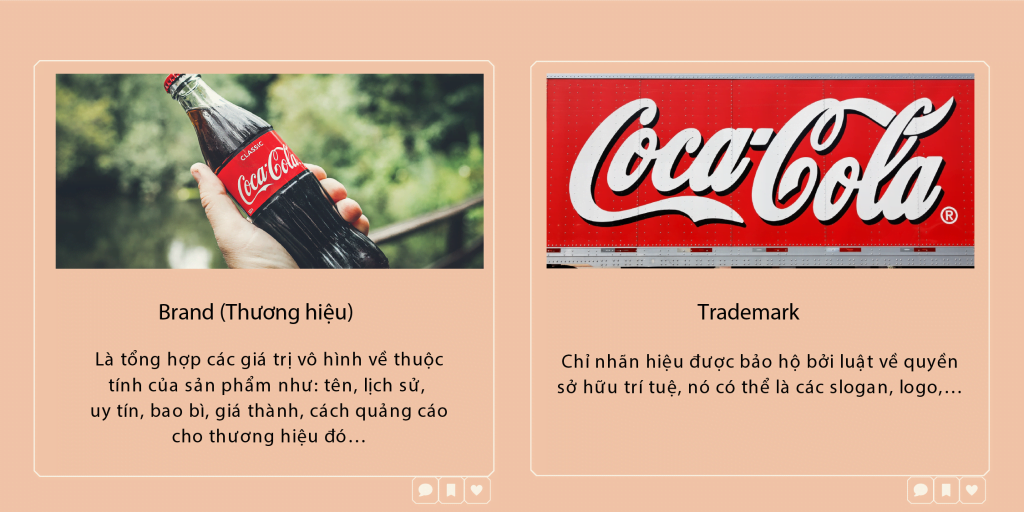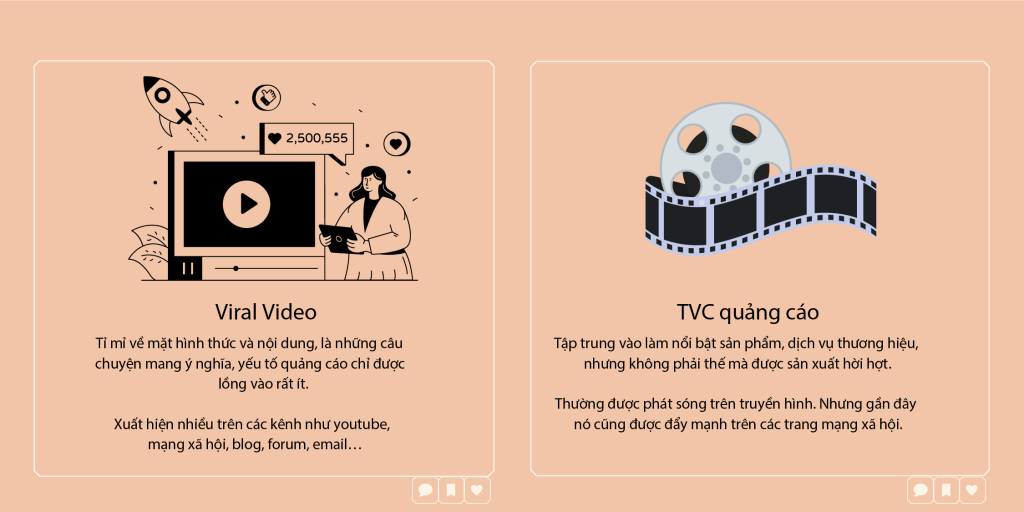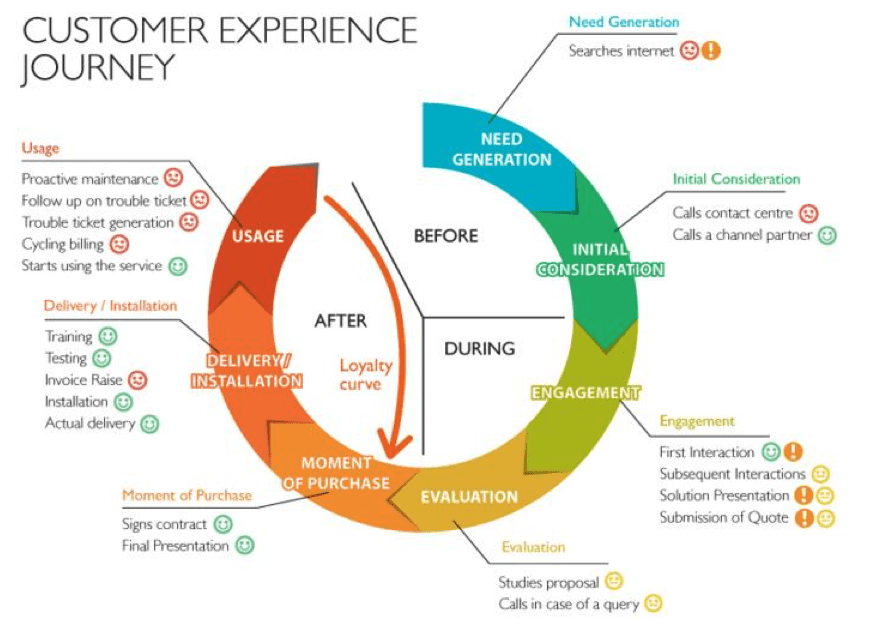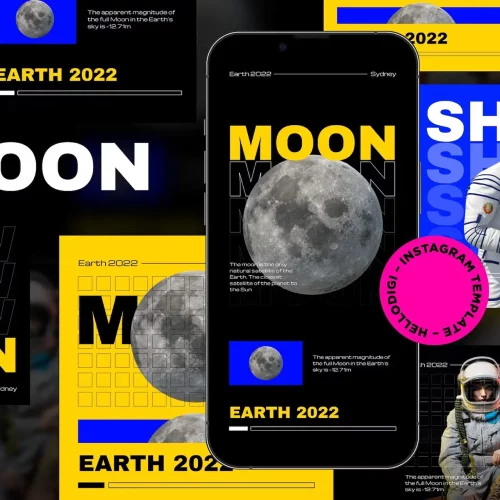If you think Digital Marketing and Online Marketing are the same, you are wrong! They are two different concepts. In fact, in Marketing, there are many pairs of phrases that many people are confused about. In this article, let’s explore the most common marketing terms with Malu.
1. Distinguishing Digital Marketing and Online Marketing

Digital Marketing is a way of marketing using existing digital platforms and types (Telephone, Internet, TV, Audio, Digital OOH…).
Meanwhile, Online Marketing : A marketing method that can only be built and implemented on the Internet space, including major platforms such as Social Media, Website, Display Ad…
In short, Online Marketing is a “sub-file” of Digital Marketing. Although both are developed based on technology, but Digital Marketing is a form of marketing that is not limited to the Internet but also includes offline forms.
>>> Maybe you are interested: What is the difference between Digital Marketing and Online Marketing?
2. Brand and Trademark

Brand , also known as brand, is a combination of intangible values of product attributes such as: name, history, reputation, packaging, price, advertising for that brand… Understandably, Brand is something that is deeply imprinted in the customer’s mind, is how people perceive your business, especially it is the emotional bridge.
Trademark is only a trademark protected by intellectual property law, it can be slogans, logos, etc.
For example, Coca-Cola is the brand name, and the red letter symbol in the Coca-Cola logo is the legal trademark for that brand.
A brand can have many different trademarks. For example, Volkswagen is a German car brand that owns and manufactures different car lines such as Audi, Bentley, Lamborghini, Porsche… Although Audi or Bentley themselves are both trademarks, they have all been registered. Signed for ownership and protection, so they are all trademarks of the Volkswagen brand.
3. Consumer and Customer

It is also one of the most misunderstood marketing terms for marketers. So what is the difference between Consumer and Customer?
Consumer (Consumer)
This is the final object of the service/goods supply process. They are the people who directly use products and services in the market.
Customer (Customer)
This is the object directly involved in the exchange and purchase of goods and products from the supplier. The customer is not necessarily an individual, but can be an agent or an organization that wants to make a purchase.
For example: Company A has a milk product for children under 10 years old, the consumers here are children under 10 years old, but the customers are the parents of the children.
4. Goals and Objectives

Goals – Purpose This can be understood as the final destination of the campaign. Brands can announce goals to guide and inform the quarterly or annual strategies that the divisions will implement.
Objectives – Objectives
Meanwhile, the goal will define the specific activities that need to be done to achieve that goal.
Compare Purpose and Objective:
| Goals (Purpose) | Objectives (Goals) |
| Wide range | Specific, detailed scope |
| Valuable for establishing a common direction or vision | Link to schedule and time frame |
| Hard to measure | Easy to measure |
| Abstract ideas | Specific steps |
| Longer term | Short or medium term |
| Final result. | Means lead to the end result. |
5. Viral Video and TVC

Viral videos are often very meticulous in terms of form and content, which are meaningful stories, advertising elements are only inserted very little. Viral videos are featured a lot on channels such as youtube, social networks, blog, forum, email… Almost anywhere there is Internet, Viral video will appear there.
TVC advertising only focuses on highlighting brand products and services, but not that it is produced superficially. The average TVC duration is 60s long.
Previously, TVC advertising was usually broadcast on television mainly. But recently, in addition to TV, it is also promoted on social networking sites.
| Viral video | TVC advertising |
| Video “Jealousy Covy” goes viral to China on TikTok platform
|
Green electric TVC
|
6. PR and Advertising

PR is a communication method to convey a positive image and message about the business to customers and the community. A successful PR campaign knows how to subtly and skillfully “show off” the achievements and positive contributions of the business to the community.
Completely different from PR, Advertising “attacks” directly on target customers by emphasizing the most prominent and characteristic features of the product through TVC, Print Ad, Radio Ad, word of mouth…
300 important marketing terms to know
Marketing Terminology – Content Marketing
Content Startegy
Content Strategy, also known as content strategy, aims to provide orientations, principles, methods, foundations, etc., from which to build content for the marketing channel.
Content Shock
This term is understood as the explosion of content because content marketing activities are increasingly popular
Ebook
Ebook or a digital book designed to be read on electronic devices such as smartphones, laptops, e-readers, etc.

Messenger marketing
This is the process of generating interest in your products or services using facebook messenger or other messaging apps.
A Messenger marketing strategy that connects individuals in a way that simplifies processes, reduces ad spend, and increases ROI
ROI
ROI stands for Return on Investment and is a net ratio of total investment costs
Content pillar
This is the theme background for a piece of your website content. Conetnt Pillar serves as the main hub of content for an overarching topic.
Key Hook
Key Hook, or customer retention point, is a way of presenting news or stories to stimulate the media’s interest, thereby targeting customers and businesses.
Some common marketing terms
1. Advertising: Advertising
2. Auction-type pricing: Auction-based pricing
3. Benefit: Benefits
4. Brand acceptability: Brand acceptance
5. Brand awareness: Brand awareness
6. Brand equity: Brand value
7. Brand loyalty: Loyalty to the brand
8. Brand mark: The mark of the brand
9. Brand name: Brand name
10. Brand preference: Brand preference
11. Break-even analysis: Break-even analysis
12. Break-even point: Break-even point
13. Buyer: Buyer
14. By-product pricing: Pricing secondary products
15. Captive-product pricing: Compulsory product pricing
16. Cash discount: Discount when paying in cash
17. Cash rebate: Coupons
18. Channel level: Channel level
19. Channel management: Distribution channel management
20. Channels: Channels (distribution)

21. Communication channel: Communication channel
22. Consumer: Consumers
23. Copyright: Copyright
24. Cost: Cost
25. Coverage: Coverage (distribution channel)
26. Cross elasticity: Cross elasticity (of demand) (with substitute or complementary products
)
27. Culture: Culture
28. Customer: Customer
29. Customer-segment pricing: Pricing by customer segment
30. Decider: The person who decides (in buying behavior)
31. Demand elasticity: Elasticity of demand
32. Demographic environment: Demographic (environment) factor
33. Direct marketing: Direct marketing
34. Discount: Discount
35. Discriminatory pricing: Discriminatory pricing
36. Distribution channel: Distribution channel
37. Door-to-door sales: Door-to-door sales
38. Dutch auction: Dutch auction
39. Early adopter: The group (customer) adapts quickly
40. Economic environment: Economic environment
41. End-user: End user, end customer
42. English auction: English auction
43. Evaluation of alternatives: Evaluation of alternatives
44. Exchange: Exchange
45. Exclusive distribution: Exclusive distribution
46. Franchising: Transfer of brand privileges
47. Functional discount: Functional discount
48. Gatekeeper: Gatekeeper (in the act of buying)
49. Geographical pricing: Pricing by geographical location
50. Going-rate pricing: Pricing according to market price
51. Group pricing: Group pricing
52. Horizontal conflict: Horizontal conflict
53. Image pricing: Pricing by image
54. Income elasticity: Elasticity (of demand) with income
55. Influencer : Influencer
56. Information search: Find information
57. Initiator: The Initiator
58. Innovator: Innovative group(customers)
59. Intensive distribution: Mass distribution
60. Internal record system: Internal information system
61. Laggard: Outdated group (customers)
62. Learning curve: Experimental effect, experience effect,
learning effect
63. List price: List price
64. Location pricing: Pricing according to location and buying space
65. Long-run Average Cost – LAC: Long-run average cost
66. Loss-leader pricing: Pricing at a loss to attract customers67. Mail questionnaire: Survey method by mailing questionnaire
68. Market coverage: Market coverage
69. Marketing : Marketing
70. Marketing channel: Marketing channel
71. Marketing concept: Marketing perspective
72. Marketing decision support system: Decision support system
73. Marketing information system: Marketing information system
74. Marketing intelligence: Marketing intelligence
75. Marketing mix : Marketing mix
76. Marketing research: Marketing research
77. Markup pricing: Pricing plus costing
78. Mass-customization marketing: Mass-customization marketing
79. Mass-marketing: Mass marketing
80. Middle majority: The majority (customer) group
81. Modified rebuy: Modified rebuy
82. MRO-Maintenance Repair Operating: Industrial products in the
supply group
83. Multi-channel conflict : Multi-level conflict
84. Natural environment: Natural factors (environment)
85. Need: Need
86. Network: Network
87. New task: Buy new
88. Observation: Observation
89. OEM – Original Equipment Manufacturer: Original equipment manufacturer
90. Optional- feature pricing: Pricing according to optional features
91. Packaging: Packaging
92. Perceived – value pricing: Pricing according to perceived value
93. Personal interviewing: Face-to-face interview
94. Physical distribution: Distribution of matter
95. Place: Distribution
96. Political-legal environment: Political-legal environment
97. Positioning: Positioning
98. Post-purchase behavior: Post-purchase behavior
99. Price: Price
100. Price discount: Discount
101. Price elasticity: Elasticity (of demand) to price
102. Primary data: Primary information
103. Problem recognition: Problem recognition
104. Product: Product
105. Product Concept : Product concept
106. Product-building pricing: Package pricing
107. Product-form pricing: Pricing based on product form
108. Production concept: Production concept
109. Product-line pricing: Pricing by product family
110. Product-mix pricing: Pricing according to product strategy
111. Product-variety marketing: Product diversification marketing
112. Promotion: Promotion
113. Promotion pricing: Promotion pricing
114. Public Relation: Public Relations
115. Pull Strategy: Pull Strategy
116. Purchase decision: Buying decision
117. Purchaser: Buyer (in buying behavior)
118. Push Strategy: Push Marketing Strategy
119. Quantity discount: Discount for bulk purchase
120. Questionnaire: Questionnaire
121. Relationship marketing: Relationship Marketing
122. Research and Development (R&D): Research and Development
123. Retailer: Retailer
124. Sales concept: The point of view of selling
125. Sales information system: Sales information system
126. Sales promotion: Promotion
127. Satisfaction: Satisfaction
128. Sealed-bid auction: Private Auction
129. Seasonal discount: Seasonal discount
130. Secondary data: Secondary information
131. Segment: Segment
132. Segmentation: (Strategy) segmenting the market
133. Selective attention
134. Selective distortion: Correction
135. Selective distribution: Selective distribution
136. Selective retention: Depicts
137. Service channel: Service channel
138. Short-run Average Cost –SAC: Short-run Average Cost
139. Social – cultural environment: Socio-cultural factors
140. Social marketing concept: Social marketing perspective
141.Special-event pricing: Pricing for special events
142. Straightrebuy: Direct redemption
143. Subculture: Subculture
144. Survey: Survey
145. Survival objective: Survival objective
146. Target market: Target market
147. Target marketing: Target marketing
148. Target-return pricing: Target-return pricing
149. Task environment: Working environment
150. Technological environment: Technological factors (environment)
151. The order-to-payment cycle: The order-to-payment cycle
152. Timing pricing: Pricing according to the time of purchase
153. Trademark: Registered Trademark
154. Transaction: Transaction
155. Two-part pricing: Two-part pricing
156. User: User
157. Value: Value
158. Value pricing: Value-based pricing
159. Vertical conflict: Vertical conflict
160. Want: Want
English terms for Marketing & Communication
1. Board of Management: BOM – Board of Directors
2. General Director: GD – General Director
3. National Sale Manager: NSM – National Sales Manager
4. Deputy National Sales Manager: Deputy National Sales Manager
5. Promotion – Corner -Marketing: PCM: Promote all urgent business strategies .
6. Route To Market Manager: Head of Market Construction Department
7. Sales Capability Manager: Sales Coaching Director
8. Sales Training Manager: Regional Sales Coach
9. Trade Marketing Manager: Head of Trade Marketing Department
10. Sales Operation Manager: Head of Business Operations Department
11. Sales Logistic Manager: Head of Transportation Sales Department
12. Sales Operation department: Sales operation department
13. Sales Audit Manager: Head of market control department
14. Regional Sales Manager: RSM – Domain Sales Manager.
15. Territory Development Manager: TDM Strategic Market Development Manager .
16. Area Sales Managers: ASM – Regional Sales Manager
17. Area Marketing Manager: AMM – Regional Strategy Manager.
18. Sales Supervisors: SS – Sales Supervisor
19. Modern Trade: MT – Modern sales channel
20. Distributor Representative : DR – Sales representative from the distributor.
21. Modern Trade Supervisors: Modern Channel GSBH
22. Modern Trade Executive: Modern channel sales specialist
23. General Trade: GT – Traditional sales channel (Traditional Trade)
24. Distributor: Distributor
25. Telesales Representatives : TSR- Telesales staff.
26. Direct Sales Representative: DSRm – Direct Sales Representative.
27. Distributor Salesman: Distributor’s salesperson
28. Daily Sales Reports: DSR – Daily sales reports.
29. Daily Sell Out Reports : DSOR – Actual sales report.
30. Distributor Customer Representative : DCR – Trade Representative.
31. Outdoor Ads Strategic Planning Director: Director of outdoor advertising strategic planning .
32. OOH : Out of Home, outdoor advertising
33. Customer Services Manager: Customer Service Manager
34. OOH Manager: Head of outdoor advertising department
35. OOH Director: Outdoor advertising director36. Investment Manager: Head of Investment Department
37. Salesman: Salesman
38. Sales: Salesperson
39. Promotion program: Promotion program
40. Sample product: Sample product
41. Survey : online survey
42. Merchandising: Displaying
43. Coverage: Coverage
44. Outlet: Point of Sale
45. Wholesaler: Wholesaler
46. Scoreboard: Sales tracking board
47. Sales Target: Sales Target
48. Master coverage plan: MCP – Sales schedule
49. Key Performance Indicator: KPI – Performance Indicator
50. Point Of Sales Material: POSM – Point of sale support items
Improve English terms for Marketing & Communication
1. Advertising: Advertising
2. Auction-type pricing: Auction-based pricing
3. Benefit: Benefits
4. Brand acceptability: Brand acceptance
5. Brand awareness: Brand awareness
6. Brand equity: Brand value
7. Brand loyalty: Loyalty to the brand
8. Brand mark: The mark of the brand9. Brand name: Brand/brand name
10. Brand preference: Brand preference
11. Break-even analysis: Break-even analysis
12. Break-even point: Break-even point
13. Buyer: Buyer
14. By-product pricing: Pricing secondary products
15. Captive-product pricing: Compulsory product pricing
16. Cash discount: Discount for paying cash
17. Cash rebate: Coupons
18. Channel level: Channel level
19. Channel management: Distribution channel management
20. Channels: Channels (distribution)
21. Communication channel: Communication channel
22. Consumer: Consumers
23. Copyright: Copyright
24. Cost: Cost
25. Coverage: Coverage (distribution channel)
26. Cross elasticity: Cross elasticity (of demand) (with substitute or complementary products
)
27. Culture: Culture
28. Customer: Customer
29. Customer-segment pricing: Pricing by customer segment
30. Decider: The person who decides (in buying behavior)
31. Demand elasticity: Elasticity of demand
32. Demographic environment: Demographic (environment) factor
33. Direct marketing: Direct marketing
34. Discount: Discount35. Discriminatory pricing: Discriminatory pricing
36. Distribution channel: Distribution channel
37. Door-to-door sales: Door-to-door sales
38. Dutch auction: Dutch auction
39. Early adopter: The group (customer) adapts quickly

40. Economic environment: Economic factors (environment)
41. End-user: End user, end customer
42. English auction: English auction
43. Evaluation of alternatives: Evaluation of alternatives
44. Exchange: Exchange
45. Exelusive distribution: Exclusive distribution
46. Franchising: Transfer of business privileges
47. Functional discount: Functional discount
48. Gatekeeper: Gatekeeper (in the act of buying)
49. Geographical pricing: Pricing by geographical location
50. Going-rate pricing: Pricing according to market price
51. Hori/ontal conflict: Horizontal conflict
52. Image pricing: Pricing by image
53. Income elasticity: Elasticity (of demand) with income
54. Influencer: Photo person
55. Group pricing: Pricing according to beneficiary groups
56. Information search: Information search
57. Initiator: The Initiator
58. Innovator: Innovative group(customers)
59. Intensive distribution: Mass distribution
60. Internal record system: Internal information system
61. Laggard: Outdated group (customers)
62. Learning curve: Experimental effect, experience effect,
learning effect
63. List price: List price
64. Location pricing: Pricing according to location and buying space
65. Long-run Average Cost – LAC: Long-run average cost
66. Loss-leader pricing: Pricing at a loss to attract customers
67. Mail questionnaire: Survey method by mailing questionnaire
68. Market coverage: Market coverage
69. Marketing: Marketing
70. Marketing channel: Marketing channel
71. Marketing concept: Marketing perspective
72. Marketing decision support system: Decision support system
73. Marketing information system: Marketing information system
74. Marketing intelligence: Marketing intelligence
75. Natural environment: Natural factors (environment)
76. Need: Need
77. Network: Network
78. Newtask: Buy new.
79. Marketing mix: Marketing mix
80. Marketing research:Marketing research
81. Markup pricing: Pricing plus costing
82. Mass-customization marketing: Mass-customization marketing
83. Mass-marketing: Mass marketing
84. Middle majority: The majority (customers)
85. Modified rebuy: Modified rebuy
86. MRO-Maintenance Repair Operating: Industrial products in the
supply group
87. Multi-channel conflict: Multi-level conflict
88. Observation: Observation
89. OEM – Original Equipment Manufacturer: Original equipment manufacturer
90. Optional- feature pricing:Pricing by optional features
91.Packaging: Packing
92. Perceived – value pricing:Price based on perceived value
93. Personal interviewing: Face-to-face interview
94. Physical distribution: Distribution of matter
95. Quantity discount: Discount for bulk purchase
96. Questionnaire: Questionnaire.
97. Place: Distribution
98. Political-legal environment: Political-legal environment
99. Positioning: Positioning
100. Post-purchase behavior: Post-purchase behavior
101. Price: Price
102. Price discount: Discount
103. Price elasticity: Elasticity (of demand) to price
104. Primary data: Primary information
105. Problem recognition: Problem recognition
106. Product: Product
107. Product Concept: Product concept
108. Product-building pricing : Package pricing
109. Product-form pricing Pricing by product form
110. Production concept: Production concept
111. Product-line pricing: Pricing by product family
112. Product-mix pricing: Pricing according to product strategy
113. Product-variety marketing:Product diversification marketing
114. Promotion: Promotion
115. Promotion pricing: Promotion pricing
116. Public Relation: Community Relations
117. Pull Strategy: Pull Strategy
118. Purchase decision: Buying decision
119. Purchaser: Buyer (in buying behavior)
120. Push Strategy: Push Marketing Strategy
121. Relationship marketing: Relationship Marketing
122. Research and Development(R&D): Research and Development
123. Retailer: Retailer
124. Sales concept: The point of view of selling
125. Sales information system: Sales information system
126. Sales promotion: Promotion
127. Satisfaction: Satisfaction
128. Sealed-bid auction: Private Auction
129. Seasonal discount: Seasonal discount
130. Target market: Target market
131. Target marketing: Target marketing
132. Target-return pricing: Target-return pricing
133. Task environment: Working environment
134. Technological environment: Technological (environmental) factors.
135. Secondary sata: Secondary information
136. Segment: Segment
137. Segmentation: (Strategy) market segmentation
138. Selective attention
139. Selective distortion: Correction
140. Selective distribution: Filtered distribution
141. Selective retention: Description142. Service channel: Service channel
143. Short-run Average Cost –SAC: Short-run Average Cost
144. Social –cultural environment: Sociocultural (environmental) factors
145. Social marketing concept: Social marketing perspective
146. Special-event pricing: Pricing for special events
147. Straight rebuy: Direct rebuy
148. Subculture: Subculture
149. Survey: Article
150. Traeyele: Order and Pay Cycle
151. Timing pricing: Pricing according to the time of purchase
152. Trademark: Registered Trademark
153. Transaction: Transaction
154. Two-part pricing: Two-part pricing
155. Survival objective: Survival objective
156. User: User
157. Value: Value
158. Value pricing: Value-based pricing
159. Vertical conflict: Vertical conflict
160. Want: Want
161. Wholesaler: Wholesaler
Ending
The above concepts of marketing terms are very confusing because they are not too different from the outside, distinguishing these terms will help Marketers clearly define the direction in the industry, as well as deploy the campaign more carefully and sharper. .





